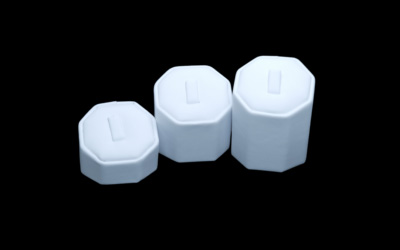Even the most exquisite piece of jewellery if displayed poorly can fail to stun those viewing it, like any art piece how something is displayed has a huge impact on how it is received. Museums and Art Galleries are masters at making things look their best, so what can we take away from their displays to use on our own?
How to Display Jewellery for Sale
Most retailers who work with jewellery know to group alike pieces together be it by stone, metal or style. This helps clients more easily find pieces that suit their preferences and shop for pieces that work well when worn together. Art Galleries will do similar things with their collections, so someone interested in a particular artist or period can browse only that section.
From there it is easy to see how each section can be adapted to best show the pieces displayed, just as art galleries will change lighting and wall colour to best display pieces the same can be done in jewellery displays, for example, silver pieces could get lost if displayed under bright lights on a white necklace bust background but appear far more striking with the same lighting on black necklace busts. That same white stand might be the perfect complement to a chunky piece that might be weighed down on a dark stand.
Trying to convey value is another obstacle when displaying pieces for sale, art galleries are a great example of one of the major factors in this at work, space. In galleries, each piece is displayed with quite a bit of space around it so that each item can be viewed individually without interference. For example, placing a ring in its own stand rather than in a cushion with a number of others, or simply having more space around each ring rather than trying to entirely fill the tray.
This aesthetic of empty space has now been associated with expensive pieces, and with good reason, being able to only place a few pieces up for perusal while still being able to afford the overhead costs for the space they are being sold in implies that each piece is of a high calibre.
Allowing a space to be too cluttered can make even pieces of extremely high quality seem less valuable, which leads to a disconnect with customers, who may back off a piece they would have otherwise purchased simply because it seems overpriced due to its subpar presentation.
How to Display Jewellery on a Stall
But what can be done if you are limited to a smaller space and can’t afford the luxury of large empty spaces in your stall? Many independent artisans rent smaller spaces or display at various conventions which means space is tighter than usual but that doesn’t mean that there aren’t tricks to be learnt from galleries.
The first concept that can be copied is custom placards, many people attach to the story behind a piece, and if your stall is unmanned or you’re simply busy you may not have the chance to explain things yourself. Having a small card that explains the process of making a piece, its symbolism or other interesting facts about a piece can help people fall in love with a particular item or even your style of making in general. Individual placards for different pieces can also make it clearer that pieces are handmade and or one of a kind, which adds to an item’s value and appeal.
Glass displays are also a great addition. While many pieces, especially if they are uniquely expensive, are already kept under lock and key, adding a glass case can help convey that same value regardless, it can also help you stand apart from other stalls especially if you find a case that matches your brand aesthetic, clean edges and a seamless design for modern pieces whereas a vintage-inspired stall may have something with metal filigree legs or a velvet tray base.
Glass cases can also add interest if you have space for some of your pieces to sit outside of the case and some in, splitting your pieces like this also offers the benefit of being able to visually divide your more luxury pieces from your budget options.
How to Display Jewellery in an Exhibition
Naturally, the most obvious place to find inspiration in galleries and museums is when jewellery is being displayed in similar spaces like an exhibition. While some spaces will have embedded glass cabinets or freestanding glass cases where jewellery can be displayed in a more typical fashion there are other exhibitions that only allow for wall space, what can be done then?
Beyond backing colours as already discussed, frames are another thing to note. Just as with paintings and the like, more traditional pieces tend to be placed in decorative frames as they seem incomplete without them whereas more modern pieces would be weighed down or thrown off by such things. Placing jewellery not simply onto the wall but mounted on a square of fabric or colour or even in decorative frames can help anchor a piece and make it feel more substantial in a space.
Galleries are experts at the display and sale of art pieces and have been developing methods that work for centuries, so if you are struggling with how best to display the wearable art you need to or want to change up your current displays but don’t know where to start, it might be an idea to go to a local gallery and see what tricks you can utilise in your own spaces.





